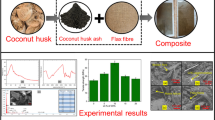Abstract
Counteracting moisture ingress in wood and wood based products is crucial for service life prolongation. The use of solvent- as well as water-based organosilicons as envelope treatments on such materials is investigated. Therefore, organosilicons were applied onto four different substrates like OSB and MDF as well as solid wood and plywood. Both treated as well as untreated materials were subjected to a series of floating and imbibition protocols in combination with artificial weathering in order to quantify their hydrophobing action. Envelope treatments of organosilicons show potential in improving water repellent characteristics of solid wood and plywood but have a reduced effectiveness after artificial weathering. The wood based panels OSB and MDF behave opposite. Further research is needed to validate hypotheses on this.
Zusammenfassung
Um die Nutzungsdauer von Holz und Holzwerkstoffen zu verlängern, ist es wichtig, der Aufnahme von Feuchtigkeit entgegenzuwirken. Untersucht wird die Verwendung von lösemittel- sowie wasserbasierten Organosiloxanen zur Oberflächenbehandlung dieser Materialien. Dazu wurden Organosiloxane auf vier verschiedene Werkstoffe, nämlich OSB und MDF sowie Massivholz und Sperrholz, aufgetragen. Sowohl behandelte als auch unbehandelte Proben wurden einer Reihe von Wasserlagerungs- und Tauchversuchen und künstlicher Bewitterung unterzogen, um die hydrophobierende Wirkung zu bestimmen. Die Oberflächenbehandlung mit Organosiloxanen zeigte Potential, die wasserabstoßenden Eigenschaften von Massivholz und Sperrholz zu verbessern, allerdings mit reduzierter Wirkung nach künstlicher Bewitterung. OSB und MDF verhalten sich entgegengesetzt. Zur Bestätigung dieser Hypothesen sind weitere Untersuchungen erforderlich.








Similar content being viewed by others
References
Ahola A, Derbyshire H, Hora G, de Meijer M (1999) Water protection of wooden window joinery with low organic solvent content paints with known composition. Holz Roh- Werkst 57:45–50
Candanedo L, Derome D (2005) Numerical simulation of water absorption in softwood. In: Proceedings of the ninth international IBPSA conference, pp 123–130
de Meijer M, Militz H (2000) Moisture transport in coated wood, part 1: analysis of sorption rates and moisture content profiles in spruce during liquid water uptake. Holz Roh- Werkst 58:354–362
De Vetter L (2009) Organosilicon compounds as potential wood protecting agents. Dissertation, Ghent University
De Vetter L, Cnudde V, Masschaele B, Jacobs PJS, Van Acker J (2006) Detection and distribution analysis of organosilicon compounds in wood by means of SEM-EDX and micro-CT. Mater Charact 56:39–48
De Vetter L, Stevens M, Van Acker J (2009) Fungal decay resistance and natural durability of organosilicon treated wood. Int Biodeterior Biodegrad 63:130–134
Donath S, Militz H, Mai C (2006) Creating water repellent effects on wood by treatment with silanes. Holzforschung 60:40–46
EN 13986 (2002) Wood-based panels for use in construction—characteristics, evaluation of conformity and marking
Hager R (1995) Waterborne silicones as wood preservatives. IRG/WP/95-30062. The International Research Group on Wood Protection, Stockholm, Sweden
Hens H (2007) Building physics—heat, air and moisture. Fundamentals and engineering methods with examples and exercises. Ernst & Sohn Verlag, Berlin
Hora G (1994) The dynamic contact angle. A characteristic to predict the lifetime of a wood topcoat. J Coat Technol Res 66:55–59
Krus M, Hansen KK, Künzel HM (1997) Porosity and liquid absorption of cement paste. Mater Struct 30:394–398
Kumaran MK (1999) Moisture diffusivity of building materials from water absorption measurements. J Therm Envel Build Sci 22:349–355
Lukowsky D, Peek RD (1997) Water-based silicones on wood. IRG/WP/97-30144. The International Research Group on Wood Protection, Stockholm, Sweden
Lukowsky D, Farnow M, Rypstra T (1998) Some aspects of testing water repellents. IRG/WP 98-40113. The International Research Group on Wood Protection, Stockholm, Sweden
Miniotaite R (2005) Hygric properties of building materials. In: Proceedings of the 7th Nordic symposium on building physics, Reykjavík
Mukhopadhyaya P, Kumaran K, Normandin N, Goudreau P (2002) Effect of surface temperature on water absorption coefficient of building materials. J Therm Envel Build Sci 26:179–195
Niu YR, Liu XY, Zheng XB, Ji H, Ding C (2009) Microstructure and properties characterization of silicon coatings prepared by vacuum plasma spraying technology. J Therm Spray Technol 18(3):427–434
Nofal M, Kumaran K (1999) Behaviour of engineered wood materials under the effect of wetting and drying cycles. In: Proceedings of the 10th international conference on building physics and building technology, pp 193–203
Noll W (1968) Chemistry and technology of silicones. Academic Press, London
Ren KB, Kagi DA (1995) Study of water repellent effect of earth substrates impregnated with water-based silicones. J Chem Technol Biotechnol 63:237–246
Roels S, Carmeliet J, Hens H, Adan O, Brocken H, Cerny R, Pavlik Z, Hall C, Kumaran K, Pel L, Plagge R (2004) Interlaboratory comparison of hygric properties of porous building materials. J Therm Envel Build Sci 27:307–325
Singh AP, Dawson BSW (2004) Confocal microscope—a valuable tool for examining wood-coating interface (short communication). J Coat Technol Res 1:235–237
Van den Bulcke J, Boone M, Van Acker J, Van Hoorebeke L (2010) High-resolution X-ray imaging and analysis of coatings on and in wood. J Coat Technol Res 7:271–277
Van den Bulcke J, Rijckaert V, Van Acker J, Stevens M (2003) Quantitative measurement of the penetration of water-borne coatings in wood with confocal lasermicroscopy and image analysis. Holz Roh- Werkst 61:304–310
Acknowledgements
Since the European Commission supported the research project HYDROPHOB (QLK5-CT-2002-01439), which was the framework for this study, the authors would like to thank the Commission for the financial support. The authors also wish to thank the Fund for Scientific Research-Flanders (FWO, Belgium) for the postdoctoral funding granted to the second author.
The authors declare that they have no conflict of interest.
Author information
Authors and Affiliations
Corresponding author
Rights and permissions
About this article
Cite this article
De Vetter, L., Van den Bulcke, J. & Van Acker, J. Envelope treatment of wood based materials with concentrated organosilicons. Eur. J. Wood Prod. 69, 397–406 (2011). https://doi.org/10.1007/s00107-010-0448-4
Received:
Published:
Issue Date:
DOI: https://doi.org/10.1007/s00107-010-0448-4




